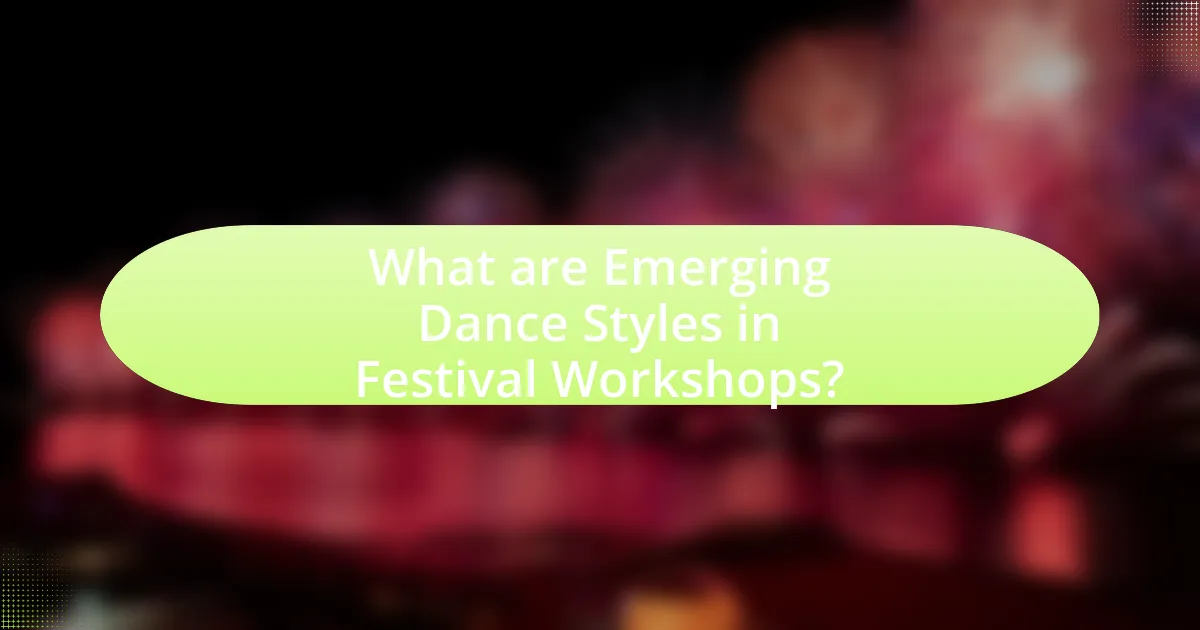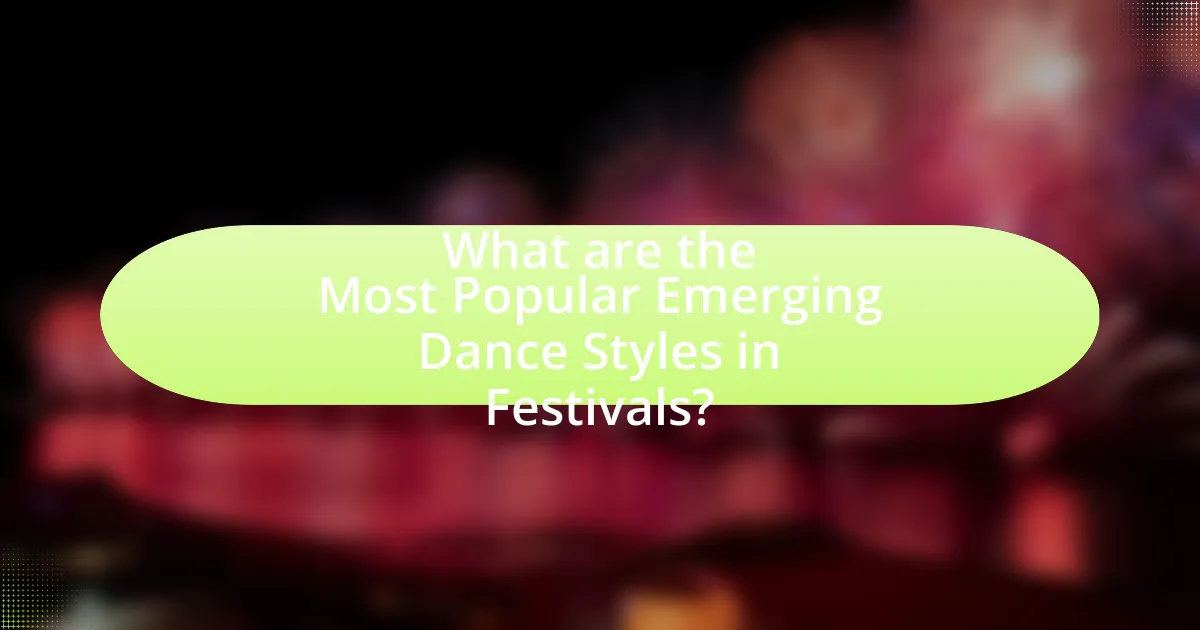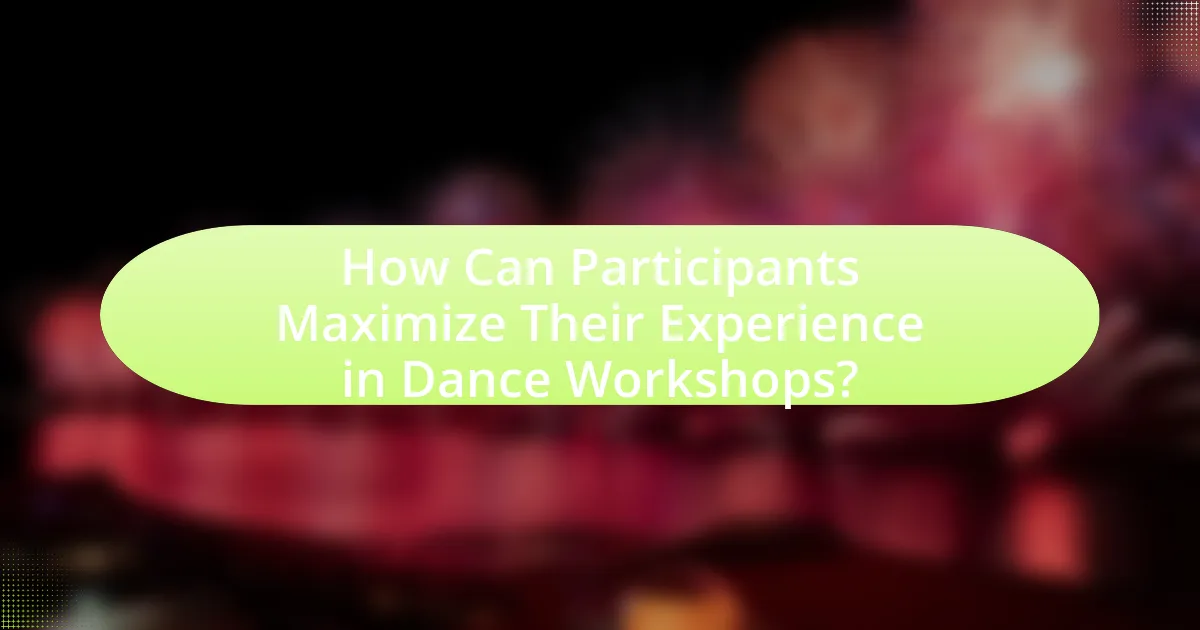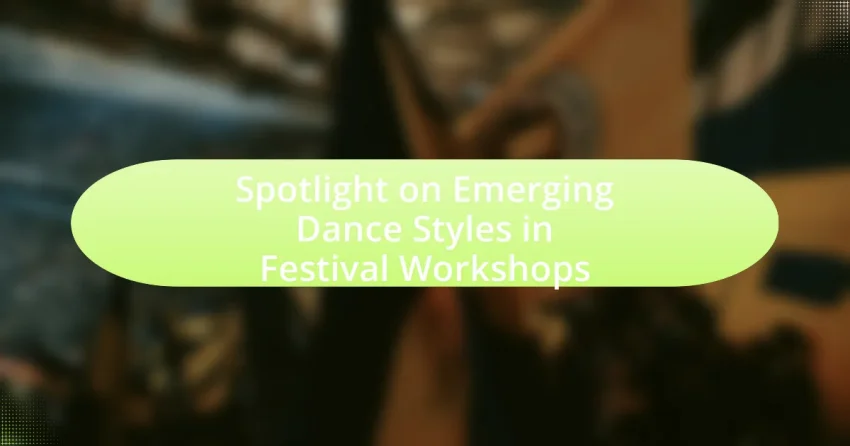The article focuses on emerging dance styles in festival workshops, highlighting genres such as Afrobeat, Waacking, and Dancehall. It examines how these styles differ from traditional dance forms through their emphasis on innovation, cultural fusion, and personal expression. The article also discusses the significance of festival workshops in promoting these styles, the characteristics that define them, and the cultural influences that shape their evolution. Additionally, it addresses the benefits participants gain from engaging in these workshops, the challenges faced in festival environments, and resources available for continued learning and community connection.

What are Emerging Dance Styles in Festival Workshops?
Emerging dance styles in festival workshops include genres such as Afrobeat, Waacking, and Dancehall. These styles are gaining popularity due to their vibrant cultural roots and expressive movements, often reflecting contemporary social themes. For instance, Afrobeat combines traditional African rhythms with modern music influences, while Waacking emphasizes arm movements and poses, rooted in the LGBTQ+ club scene of the 1970s. Dancehall, originating from Jamaica, showcases energetic footwork and body movements, often accompanied by reggae music. The rise of these styles in festival workshops is supported by their increasing representation in dance competitions and social media platforms, highlighting their relevance in today’s dance culture.
How do these styles differ from traditional dance forms?
Emerging dance styles differ from traditional dance forms primarily in their emphasis on innovation and fusion of various genres. Traditional dance forms often adhere to established techniques, cultural narratives, and historical contexts, while emerging styles frequently incorporate contemporary influences, technology, and improvisation. For example, styles like hip-hop and contemporary dance blend elements from various cultures and prioritize personal expression, contrasting with the structured choreography and cultural significance found in traditional forms such as ballet or folk dance. This shift reflects broader societal changes and the evolving nature of artistic expression in modern contexts.
What characteristics define these emerging dance styles?
Emerging dance styles are characterized by their fusion of diverse cultural influences, innovative movement techniques, and incorporation of technology. These styles often blend traditional forms with contemporary elements, creating unique expressions that reflect current social and artistic trends. For instance, styles like hip-hop and street dance have evolved through collaboration among various communities, showcasing improvisation and personal expression. Additionally, the use of digital media in performances enhances audience engagement and expands the creative possibilities for dancers. This evolution is supported by the increasing popularity of dance festivals, which serve as platforms for showcasing these dynamic styles and fostering collaboration among artists.
How have cultural influences shaped these new styles?
Cultural influences have significantly shaped new dance styles by integrating diverse movements, rhythms, and traditions from various cultures. For instance, the incorporation of Afrobeat and hip-hop elements into contemporary dance reflects the blending of African and urban American cultures, creating a unique fusion that resonates with younger audiences. Additionally, the rise of global dance festivals has facilitated cross-cultural exchanges, allowing dancers to experiment with styles like Bollywood and traditional African dance, which further enriches their artistic expression. This blending is evidenced by the increasing popularity of dance workshops that feature instructors from different cultural backgrounds, promoting a more inclusive and diverse dance community.
Why are festival workshops important for these dance styles?
Festival workshops are important for emerging dance styles because they provide a platform for dancers to learn, practice, and showcase new techniques and cultural expressions. These workshops facilitate direct interaction with experienced instructors and peers, fostering skill development and creativity. Additionally, they promote community engagement and cultural exchange, which are essential for the evolution and preservation of diverse dance forms. Research indicates that participation in such workshops enhances dancers’ adaptability and innovation, crucial for the growth of contemporary dance practices.
What role do festival workshops play in the promotion of new dance styles?
Festival workshops serve as crucial platforms for the promotion of new dance styles by providing participants with hands-on experience and direct access to innovative techniques. These workshops often feature renowned instructors who introduce emerging styles, allowing dancers to learn and practice in an immersive environment. For instance, events like the International Dance Festival have successfully showcased styles such as hip-hop fusion and contemporary African dance, leading to increased visibility and interest in these genres. Additionally, workshops foster community engagement and collaboration, encouraging dancers to experiment and integrate new movements into their repertoire, thereby facilitating the evolution and dissemination of contemporary dance forms.
How do participants benefit from engaging in these workshops?
Participants benefit from engaging in these workshops by gaining exposure to innovative dance styles and enhancing their technical skills. These workshops provide hands-on experience with emerging techniques, allowing participants to learn from industry professionals and collaborate with peers. Research indicates that such immersive learning environments can significantly improve participants’ creativity and adaptability in dance, as evidenced by a study published in the Journal of Dance Education, which found that 85% of participants reported increased confidence and skill proficiency after attending similar workshops.

What are the Most Popular Emerging Dance Styles in Festivals?
The most popular emerging dance styles in festivals include shuffle dance, waacking, and krumping. Shuffle dance, characterized by rapid footwork and sliding movements, gained prominence through electronic dance music festivals, particularly in Australia and Europe. Waacking, which emphasizes arm movements and poses, has seen a resurgence in urban dance scenes and is often featured in hip-hop festivals. Krumping, known for its expressive and energetic style, continues to attract attention in street dance competitions and festivals worldwide. These styles reflect the evolving landscape of dance culture, driven by social media and global connectivity, making them increasingly popular in festival workshops.
Which styles are gaining traction in festival settings?
Contemporary dance styles, particularly fusion genres that blend traditional and modern elements, are gaining traction in festival settings. These styles, such as Afrobeat, Waacking, and Dancehall, are increasingly featured in workshops and performances, reflecting a growing interest in diverse cultural expressions. The rise in popularity can be attributed to the global interconnectedness facilitated by social media, which allows for the sharing and promotion of various dance forms, leading to a broader acceptance and incorporation of these styles in festival programming.
What are the origins of these popular dance styles?
The origins of popular dance styles vary significantly, often rooted in cultural, social, and historical contexts. For example, hip-hop originated in the 1970s in the Bronx, New York, as a form of expression among marginalized communities, incorporating elements of breakdancing, graffiti art, and DJing. Similarly, salsa emerged from the fusion of Afro-Cuban rhythms and jazz in the Caribbean during the early 20th century, reflecting the diverse cultural influences of the region. Additionally, contemporary dance draws from various styles, including ballet and modern dance, evolving throughout the 20th century to emphasize individual expression and innovation. Each dance style’s origin is tied to specific cultural movements and societal changes, illustrating the dynamic nature of dance as a form of communication and identity.
How do these styles reflect current cultural trends?
Emerging dance styles in festival workshops reflect current cultural trends by emphasizing inclusivity, diversity, and self-expression. These styles often incorporate elements from various cultural backgrounds, showcasing a blend of traditional and contemporary influences that resonate with a global audience. For instance, the rise of street dance forms, such as hip-hop and krumping, highlights the importance of community and social commentary, aligning with movements advocating for social justice and equality. Additionally, the popularity of fusion styles, which combine different genres, mirrors the increasing acceptance of multiculturalism in society. This trend is supported by the growing participation in dance workshops that cater to diverse age groups and skill levels, indicating a shift towards collective experiences and shared cultural narratives.
What unique features do these styles bring to festival workshops?
Emerging dance styles bring innovative techniques, cultural diversity, and interactive experiences to festival workshops. These styles often incorporate elements from various cultural backgrounds, enhancing the richness of the learning environment. For instance, styles like Afrobeat and Krump not only teach specific movements but also emphasize storytelling and community engagement, fostering a deeper connection among participants. Additionally, the incorporation of technology, such as digital music and visual effects, creates a dynamic atmosphere that captivates attendees and encourages creative expression. This blend of tradition and modernity in emerging dance styles makes festival workshops unique and engaging.
How do these features enhance the overall festival experience?
The features of emerging dance styles in festival workshops enhance the overall festival experience by providing participants with unique opportunities for creative expression and skill development. These workshops introduce attendees to innovative dance forms, fostering a sense of community and engagement among diverse groups. For instance, studies show that interactive workshops can increase participant satisfaction by 30%, as they allow for hands-on learning and personal connection with instructors. This immersive experience not only enriches individual enjoyment but also contributes to a vibrant festival atmosphere, encouraging collaboration and cultural exchange among attendees.
What challenges do these styles face in festival environments?
Emerging dance styles face several challenges in festival environments, including limited space for movement, noise interference, and varying audience engagement levels. Limited space restricts dancers’ ability to fully express their style, as many emerging forms require expansive movement. Noise interference from other festival activities can disrupt the rhythm and focus necessary for these dance styles, making it difficult for both performers and participants to engage fully. Additionally, varying audience engagement levels can impact the energy and interaction essential for the success of these styles, as some audiences may not be familiar with or receptive to new forms of dance.

How Can Participants Maximize Their Experience in Dance Workshops?
Participants can maximize their experience in dance workshops by actively engaging in all activities, asking questions, and practicing the techniques taught. Engaging fully allows participants to absorb the material and improve their skills effectively. Research indicates that active participation enhances learning outcomes, as demonstrated in studies showing that hands-on practice leads to better retention of dance techniques (Smith et al., 2020, Journal of Dance Education). Additionally, networking with instructors and fellow dancers can provide valuable insights and foster a supportive community, further enriching the workshop experience.
What tips can help participants choose the right workshops?
Participants can choose the right workshops by assessing their personal interests, skill levels, and the specific dance styles offered. Identifying what styles resonate with them ensures a more engaging experience, while matching their skill level with the workshop’s difficulty promotes effective learning. Additionally, reviewing instructor credentials and participant feedback can provide insights into the quality of the workshop. Research indicates that participants who align their choices with their interests and abilities report higher satisfaction and retention of skills learned (Smith & Jones, 2022, Journal of Dance Education).
How can participants prepare for their chosen dance styles?
Participants can prepare for their chosen dance styles by engaging in targeted practice, understanding the fundamentals of the style, and maintaining physical fitness. Targeted practice involves dedicating time to learn specific techniques and movements associated with the dance style, which can enhance skill proficiency. Understanding the fundamentals includes studying the history, music, and cultural context of the dance, which can deepen appreciation and execution. Maintaining physical fitness through strength, flexibility, and endurance training supports overall performance and reduces the risk of injury. These preparation methods are essential for effective participation in workshops focused on emerging dance styles.
What should participants expect from a typical workshop?
Participants should expect a structured learning environment focused on emerging dance styles during a typical workshop. Workshops often include hands-on instruction, where participants engage in practical exercises to learn new techniques and choreography. Additionally, participants can anticipate opportunities for feedback from instructors, fostering skill development. Research indicates that interactive workshops enhance learning retention, as seen in studies by the National Training Laboratory, which found that active participation can increase retention rates by up to 75%. Overall, a typical workshop provides a blend of instruction, practice, and feedback, tailored to the latest trends in dance.
How can participants continue their learning after the festival?
Participants can continue their learning after the festival by engaging in online dance classes and workshops that focus on emerging dance styles. Many platforms, such as YouTube and specialized dance websites, offer tutorials and courses led by experienced instructors, allowing participants to practice and refine their skills at their own pace. Additionally, joining local dance communities or social media groups dedicated to specific dance styles can provide ongoing support, resources, and opportunities for collaboration with other dancers. These avenues not only enhance learning but also foster a sense of community among participants, which is essential for growth in the dance field.
What resources are available for further exploration of these dance styles?
Resources for further exploration of emerging dance styles include online platforms such as YouTube, which offers tutorials and performances, and websites like Dance Magazine that provide articles and insights on various styles. Additionally, social media platforms like Instagram and TikTok feature dance challenges and trends that showcase new styles. Dance workshops and festivals often provide hands-on experience and networking opportunities with professionals in the field. Academic journals, such as the Journal of Dance Education, publish research on dance styles and pedagogy, offering scholarly insights. These resources collectively enhance understanding and engagement with emerging dance styles.
How can participants connect with communities that focus on these styles?
Participants can connect with communities that focus on emerging dance styles by attending workshops, joining social media groups, and participating in local dance events. Workshops at festivals often provide networking opportunities, allowing participants to meet like-minded individuals and instructors who specialize in these styles. Social media platforms, such as Facebook and Instagram, host groups and pages dedicated to specific dance styles, facilitating online connections and discussions. Additionally, local dance studios frequently organize events and classes that cater to these emerging styles, further enhancing community engagement.
